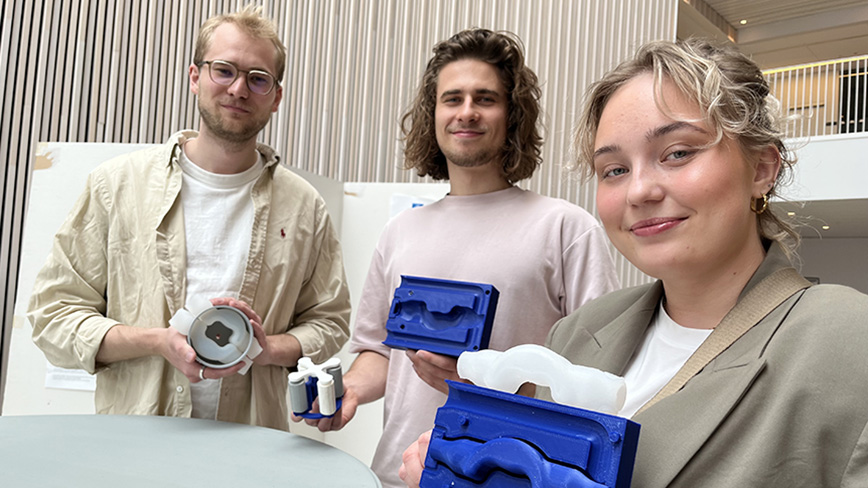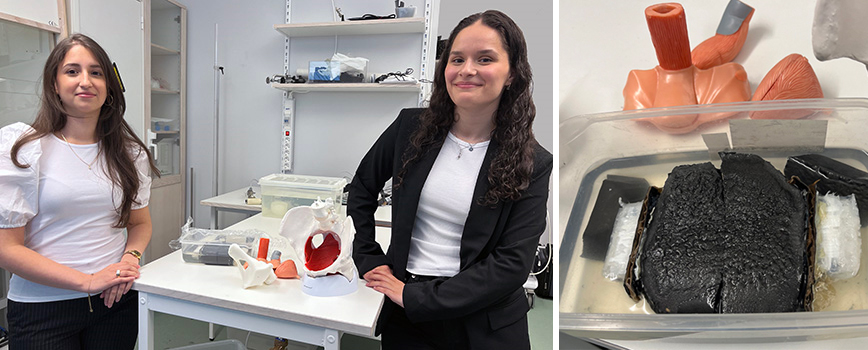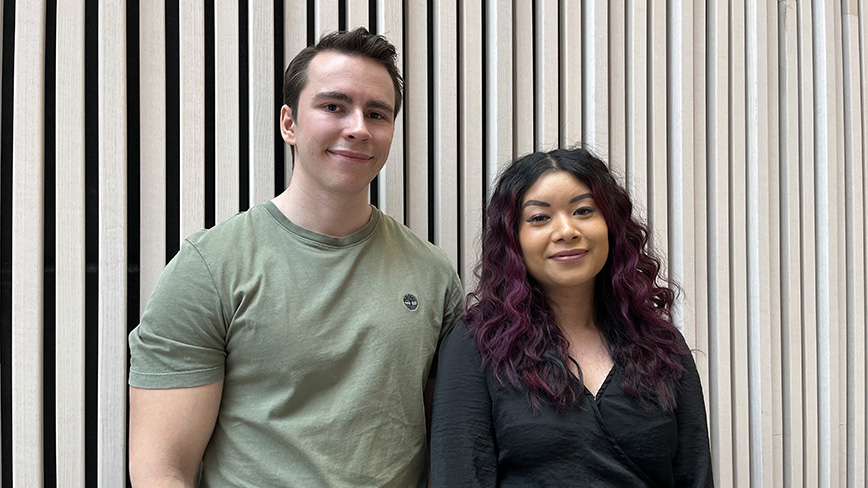Students in Flemingsberg build an artificial heart

The spring semester in Flemingsberg ended with a busy program. For two days, students got on stage to talk about their ex-jobs and projects.
“The presentation days give our students an opportunity to show off their fantastic projects,” says Matilda Larsson, professor and supervisor.
Stage fright and tense anticipation hang in the air as the students present their ex-jobs and projects to a curious audience.
In the large Jacobsson hall, Melissa Jova Martinez and Bleona Koxha present their thesis: a model of the pelvic floor muscles. The goal is to improve diagnosis and treatment of, for example, birth injuries and urinary incontinence.
Bleona and Melissa explain how muscles work and tell us that the model is built from gelatin, silicone and fishing lines. The model looks like a mysterious, dark blob, but beneath the surface, the webs of fishing lines create mechanics that correspond to a real muscle.
“How did you come up with the idea of using fishing lines?” one person wonders in the audience.
“We have plowed enormous amounts of literature. That's where we got the idea from,” answers Bleona.
This fall, Melissa and Bleona will continue to study medical technology at master's level and a new batch of students will take over the work together with doctoral student Estelle Pitti.

Creating an artificial heart
New for this year is that the students in Flemingsberg also present project work in front of an audience.
“We have developed the program in medical technology. Now, already in the first year, students can take project courses in parallel with theory courses. The new course is called ”Project course in medical technology”,” says Matilda Larsson, professor and supervisor.
One of the projects is about building an artificial heart. A heart that could become an alternative to heart transplants in the future. We meet the team behind the project just before they are to present their work to the audience in the lecture hall Jonsson Theatre.
The three master's students Matthildur Eysteinsdóttir, Salvar Andri Jóhannsson and Pierre Bourdin took on the challenge with the support of a research group led by senior lecturer Seraina Dual.
Pierre says that he made drawings in cad, while Salvar printed out the parts for the heart in a 3d printer. Matthildur has molded the vessel tubes in silicone. On the sixth attempt, the vessels got the right elasticity.
Matthildur tells us that they became so engrossed in the work in the lab that one evening they discovered they had been locked up. The school had time to close.
“We had to call the guards who let us out!” says Matthildur.
The project has gone so well that this fall the team is participating as finalists in a heart hackathon in Dallas in the USA. There they have the opportunity to present their innovative solution to researchers who specialize in artificial hearts. Until the final, work continues in Flemingsberg.
Among other things, the artificial heart will be tested in the "Hybrid Moch Loop", a machine that simulates a human's cardiovascular system. The machine makes it possible to investigate how the artificial heart would work in a human.
“We have a head start in having this opportunity at KTH!” says Salvar.
"Three years have passed so quickly"
The lecture hall is full when Viktor Lindström Söraas and Nonno Rydgren, students at Computer Technology, present their ex-jobs on the topic of user experience.
What is important to consider for a page to engage visitors? Viktor and Nonno's user tests clearly show the importance of keeping texts short and using clear graphics. They worked practically on changing and developing the "Socio Balance" page, which is a development project at KTH.
“We have mostly worked with programming that the users do not see. Now we wanted to do something that we didn't have much focus on during the education,” says Viktor.
It is the first time they speak in front of an open audience, where anyone can attend.
“A bit nervous,” says Nonno, “but it got better after a while.”
Both Viktor and Nonno are e-sports fans, but they are not interested in developing online games.
“We read ethics during the education and it made me think more about those questions. I want to do something that has a positive impact on society,” says Viktor.
Viktor would like to work with project management for programming, Nonno dreams of working in Great Britain. After Brexit, the dream has become more difficult to fulfill. Maybe there will be a job in Sweden anyway.
The students graduating this year are hardened. They had to do half the training remotely due to the pandemic.
“I am very happy that we were able to meet our course participants right at the beginning, otherwise everything would have been much more difficult,” says Viktor.
Now it's summer break for the students. The mingling that has been going on for two days in the light yard is being thinned out. Nonno Rydgren, who has her last day at KTH, sums up the time:
“Three years have passed so quickly! Even though it has been hard and stressful at times, I have gotten so much out of it. It feels successful!” says Nonno.

Text: Leena Höijer

